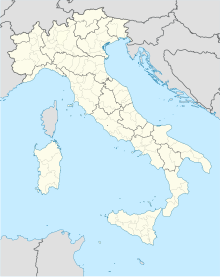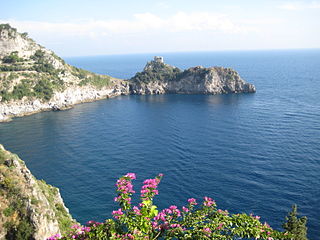
Ponza is the largest island of the Italian Pontine Islands archipelago, located 33 km (21 mi) south of Cape Circeo in the Tyrrhenian Sea. It is also the name of the commune of the island, a part of the province of Latina in the Lazio region.
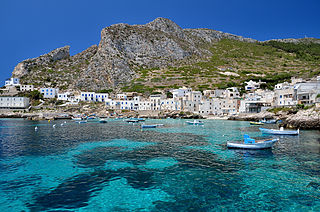
Levanzo is the smallest of the three main Aegadian Islands in the Mediterranean Sea west of Sicily, Italy. It forms a part of the municipality (comune) of Favignana in the Province of Trapani.

The Necropolis of Pantalica is a collection of cemeteries with rock-cut chamber tombs in southeast Sicily, Italy. Dating from the 13th to the 7th centuries BC, there was thought to be over 5,000 tombs, although the most recent estimate suggests a figure of just under 4,000. They extend around the flanks of a large promontory located at the junction of the Anapo river with its tributary, the Calcinara, about 23 km (14 mi) northwest of Syracuse. Together with the city of Syracuse, Pantalica was listed as a UNESCO World Heritage Site in 2005.

Lama dei Peligni is a comune and town in the Province of Chieti in the Abruzzo region of Italy with 1,155 inhabitants. It is also part of the Aventino-Medio Sangro mountain community and the municipal territory is included in the Majella National Park. The town, known to naturalists as the country of chamois, is located in a florofaunal area of particular interest.
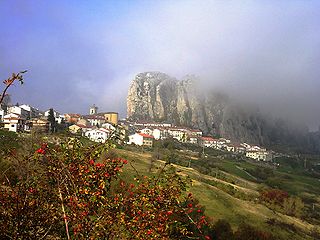
Pizzoferrato is a comune and town in the Province of Chieti in the Abruzzo region of Italy.
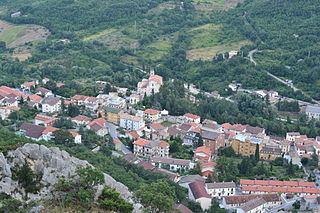
Taranta Peligna is a comune and town in the province of Chieti in the Abruzzo region of central Italy. It is 57 kilometres (35 mi) from Chieti.
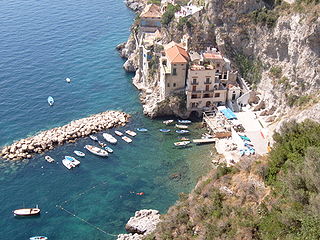
Conca dei Marini is a town and comune in the province of Salerno in the Campania region of south-western Italy. It is situated on a hill close to the coast and between Amalfi and Furore.

La figlia di Iorio, sometimes written as La figlia di Jorio, is an opera in three acts by Alberto Franchetti to a libretto by Gabriele D'Annunzio. The libretto is a very close rendering of D'Annunzio's play of the same name. La figlia di Iorio premiered at La Scala on 29 March 1906, conducted by Leopoldo Mugnone. Although the play, which had premiered two years earlier, was considered one of D'Annunzio's greatest works, the opera did not achieve a comparable success and has been rarely performed since its day.

Maiella National Park is a national park located in the provinces of Chieti, Pescara and L'Aquila, in the region of Abruzzo, Italy.
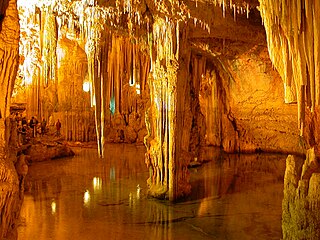
Neptune's Grotto is a stalactite cave near the town of Alghero on the island of Sardinia, Italy. The cave was discovered by local fishermen in the 18th century and has since developed into a popular tourist attraction. The grotto gets its name from the Roman god of the sea, Neptune.
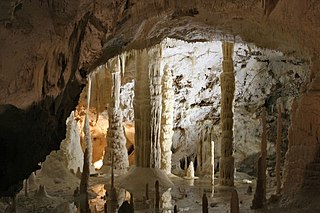
The Frasassi Caves are a karst cave system in the municipality of Genga, Italy, in the province of Ancona, Marche. They are among the most famous show caves in Italy.

The Daughter of Iorio is a 1904 play by the Italian writer Gabriele D'Annunzio. The play is written in verse and has elements of local dialect, proverbs and traditional rhymes from Abruzzo. It tells the tragic story of the love between a young female outcast and a shepherd who is being married off to a woman he does not love.

The Deer Cave is a natural cave at the Salento coast near the town of Porto Badisco, around 8 km (5.0 mi) south of Otranto in Apulia, Italy. Unknown before 1970 it came to immediate international attention after the discovery of its impressive, innovative and enigmatic complex galleries of prehistoric parietal wall paintings.
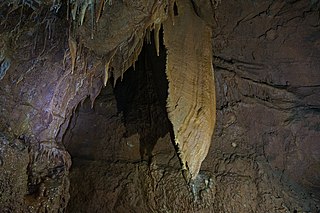
Grotta Regina del Carso is a Karst cave in the village of San Michele del Carso in the municipality of Savogna d'Isonzo. The cave is not open to public, and the access is managed by Talpe del Carso/Kraški Krti speleological group, headquartered in the vicinity of the entrance.

Pulo di Altamura is a doline located on the Murge plateau. It is the largest doline in that region and it is located about 6 kilometers (3.7 mi) north-west of the city of Altamura. It shares the local toponym pulo with other large dolines of the region, i.e. Pulicchio di Gravina, Pulo di Molfetta and Pulicchio di Toritto.

Grotta del Gelo is a volcanic cave of Mount Etna which is known for the presence of a large amount of ice. The cave formed in 1614-1624 during a large eruption of the volcano, inside one of the lava flows produced during that eruption. Within the two subsequent decades, ice grew and accumulated in the cave. Today it is a tourist destination.
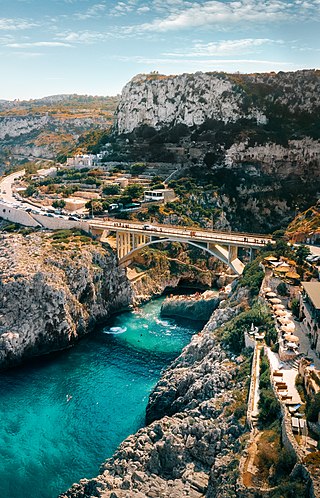
Ciolo is a narrow coastal inlet and a site of historical and environmental interest, which is located in Apulia, Italy. The location is also known as a geological site and for the presence of numerous sea caves, the largest one being the Grotta del Ciolo. Since October 2006 the Ciolo's area has become part of the Regional Park "Costa Otranto - Santa Maria di Leuca e Bosco di Tricase", created by the Apulia region to protect the eastern coast of Salento, specifically the architectural assets as well as important animal and plant species.
The 1706 Abruzzo earthquake, also known as the Maiella earthquake, occurred on November 3 at 13:00 CEST. The earthquake with a possible epicenter in the Central Apennine Mountains (Maiella), Abruzzo had an estimated moment magnitude of 6.6–6.84 Mw . It was assigned a maximum Mercalli intensity of XI (Extreme), causing tremendous destruction in Valle Peligna. At least 2,400 people were killed.

